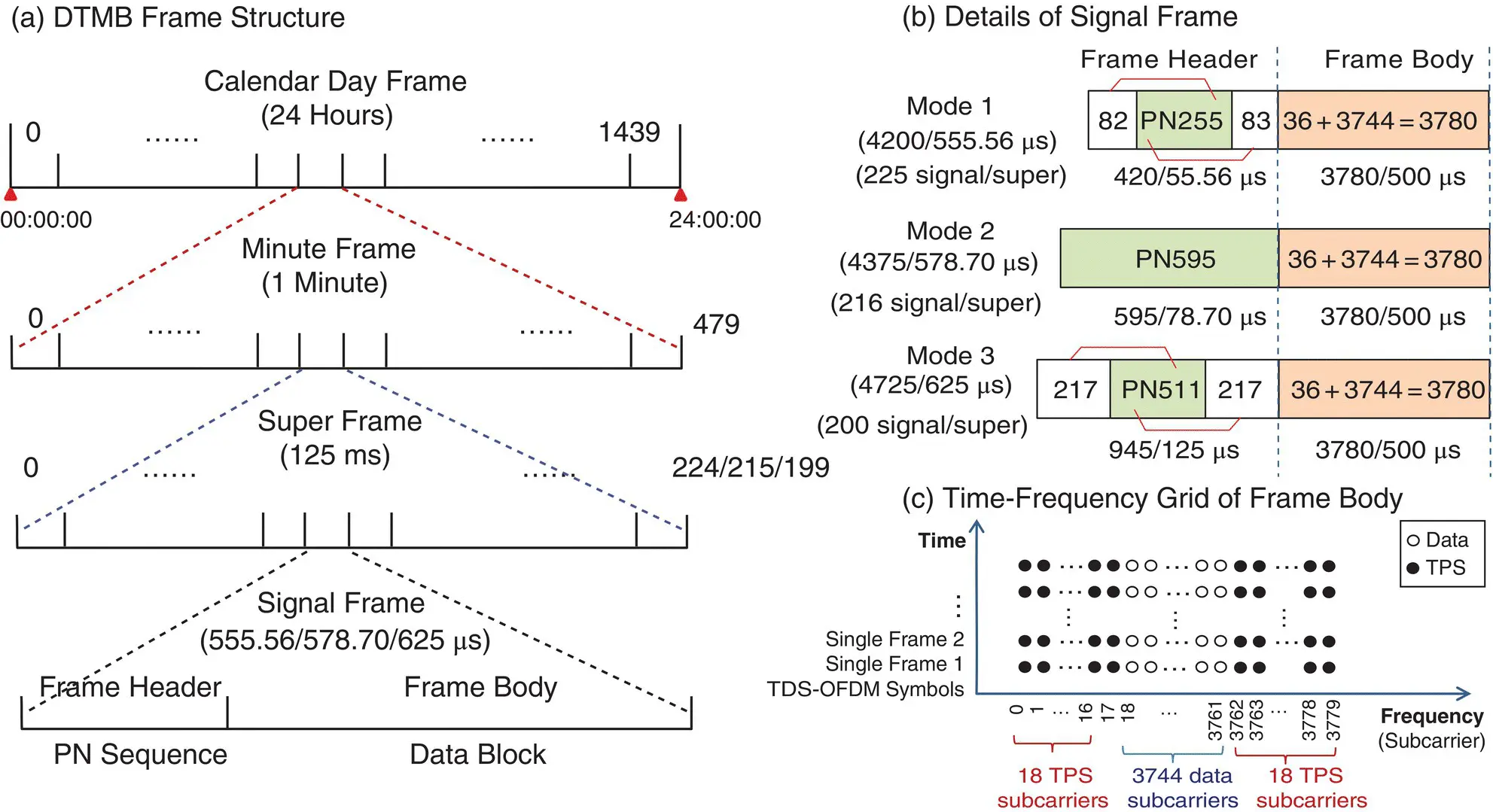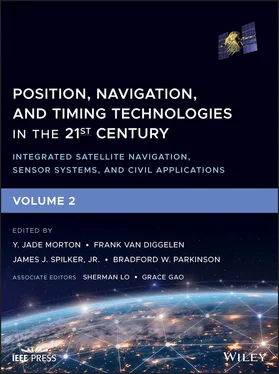Each signal frame has a frame header and a frame body, both at the same symbol rate of 7.56 million‐symbols per second (Msps). Note that the term symbol used here by DTMB is similar to that used by ATSC‐8VSB, whose duration is equivalent to the elementary period (a sample) of DVB‐T. As shown in Figure 40.14(b), the frame body is fixed with 3780 symbols over 500 μs, while the frame header has three modes to support services under different conditions. In mode 1, a frame header contains 420 symbols over 55.56 μs (FH420), which is made of an 82‐symbol front synchronization sequence (preamble), a 255‐symbol PN sequence (denoted by PN255), and an 83‐symbol rear sync sequence (post‐amble). Both the front and rear sync sequences are cyclic extensions of PN255, known as the cyclic prefix and the cyclic suffix, respectively. As a whole, a signal frame in mode 1 has 4200 symbols over 555.56 μs at a rate of 225 signal frames per super frame. The generator polynomial for PN255 is G 255= 1 + x + x 5+ x 8with a different initial condition (phase) for each signal frame to serve as an index for the signal frame [65]. When the signal frame is not indexed, the initial condition (index 0) is D 1…D 8= 00001101. The average transmission power of the frame header in mode 1 is doubled as compared to the frame body.
In mode 2, the frame header contains a single 595‐symbol PN sequence (PN595) over 78.70 μs (FH595), resulting in a signal frame of 4375 symbols over 578.70 μs at the rate of 216 signal frames per super frame. PN595 takes the first 595 symbols of a 1023‐symbol m‐sequence specified by the generator polynomial G 1023= 1 + x 3+ x 10with the initial condition being D 1…D 10= 0000000001, which is reset for each signal frame [65]. In other words, the PN595 sequence has the same phase for all signal frames. In mode 2, the frame header and frame body are transmitted using the same average power.
Finally, in mode 3, a frame header has 945 symbols over 125 μs (FH945), which is made of a 217‐symbol front synchronization sequence (cyclic prefix), a 511‐symbol PN sequence (PN511), and a 217‐symbol rear sync sequence (cyclic suffix). Again, the phase of the PN511 sequence in each signal frame differs, serving as an index for the signal frame. As a whole, a signal frame in mode 3 has 4725 symbols over 625 μs at a rate of 200 signal frames per super frame. The generator polynomial for PN511 is G 511= 1 + x 2+ x 7+ x 8+ x 9, again with a different initial condition for each signal frame as its index [65]. When the signal frame is not indexed, the initial condition (index 0) is D 1…D 9= 111011111. The average transmission power of the frame header in mode 3 is again doubled as compared to the frame body.

Figure 40.14 Frame structure of DTMB signals.
The fixed‐length frame body of 3800 symbols over 500 μs is represented in the time‐frequency grid in Figure 40.14(c), in which the central 3,744 subcarriers at a spacing of 2 kHz (from index 18 to 3761) are used to carry 3744 data symbols while the lower 18 subcarriers (index 0 to 17) and upper 18 carriers (index 3762 to 3779) are used to convey 36 information symbols for TPS.
Ranging with DTMB signals boils down to estimation of the TOA of DTMB frames, TOT of which can be derived from the frame number once decoded. The PN codes in TDS‐OFDM frame headers are designed for fast synchronization and accurate channel estimation, which have been used for the purpose in different ways [68–73]. By assuming that the frame header mode (the PN sequence) is known, these methods work well under most conditions. Some methods can operate in all three modes by constructing a local replica encompassing the three PN codes [71], via partial accumulation of delay‐multiply of samples in pre‐ and post‐ambles [74], and through detection of the frame header mode and symbol [75]. There are also methods that utilize up to three consecutive frames to acquire the PN code and estimate the frame number in a way that is insensitive to the CFO and Doppler as well as the sampling frequency offset [76].
Pseudoranges between a DTV receiver and DTV transmitters can be calculated from the decoded transmission time of DTMB frame headers and their arrival time at the receiver, measured by correlating the sampled signals with a local PN sequence [77]. Although it does not contain pilot subcarriers, the TDS‐OFDM employed by DTMB uses TPS with 36 subcarriers as shown in Figure 40.14(c) to convey system information such as the constellation mapping scheme, coding rate, and interleaving mode. The TPS is BPSK‐modulated with a much lower demodulation threshold than other higher‐order modulation schemes. Unlike SPs, the TPS of TDS‐OFDM occupies the same frequency‐domain location, unchanged from frame to frame. More importantly, the TPS does not change frequently, remaining the same for several hours and even days. Once correctly detected from previous signal frames, it can be regarded as known symbols in the subsequent symbols without the need for repeated detection, thus serving as continual pilots. Indeed, the combination of time‐domain processing of the PN sequence and the frequency‐domain processing of TPS (as pilots) provides more accurate TOA estimation for time‐frequency joint positioning [78, 79].
40.2.5 Next‐Gen ATSC 3.0 Signals for Timing and Ranging
The final digital TV technology described in this chapter is the upcoming next‐generation DTV technology called ATSC 3.0, which has great potential as a signal of opportunity for timing, ranging, and positioning applications. The standard candidates [80, 81] were announced in 2015, and the latest version was released in early 2020. Without the restriction of backward compatibility, ATSC 3.0 is purportedly “built to last” in the sense that it will avoid any future disruptive technology by allowing its layers/components to evolve gracefully and is intended to serve as a reference for future DTV worldwide!
For the end users, ATSC 3.0 will provide higher audio and video quality for both fixed and mobile reception with interactivity and personality. DTV will be made part of the Internet in three transmission modes, namely, broadcast, broadband, and push in advance. In a sense, continuous video/audio streams are broken down into data file segments accompanied by a playlist, thus allowing for watermarking‐based content recognition and easy personal advertising insertion. ATSC 3.0 will employ the state‐of‐the‐art pragmatic approach of bit‐interleaved coding and modulation (BICM), achieving the best performance as compared to A/53 [37], A/153 [41], and DVB‐T [44] in terms of the link efficiency (capacity in bits/s/Hz) as a function of signal‐to‐noise ratio (SNR) (dB) for a 6 MHz channel.
In ATSC 3.0 signal transmission, the video and audio as well as other data from content providers and studios arrive as IP packets, which are then processed in three steps. In the first step, feedforward error correction is applied, followed by bit interleaving and mapping into a modulation constellation. In the second step, symbol interleaving in time and frequency is applied prior to framing. Finally, in the third step, pilot subcarriers are added, followed by IFFT to convert it from the frequency domain to the time domain, where time guards (cyclic prefix and suffix) are added to form OFDM symbols. Preamble symbols and bootstrap symbols are finally added ahead of the payload symbols to form an ATSC frame. After DAC, the waveform undergoes power amplification and then transmission.
Читать дальше












